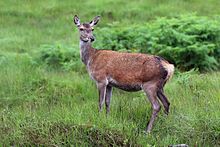Reid deer
The "Scots" that wis uised in this airticle wis written bi a body that haesna a guid grip on the leid. Please mak this airticle mair better gin ye can. |
| Reid deer | |
|---|---|

| |
| Matur male (hert) | |

| |
| Female (hind) Glen Garry, Hieland, Scotland | |
| Scientific classification | |
| Kinrick: | Animalia |
| Phylum: | Chordata |
| Cless: | Mammalia |
| Order: | Artiodactyla |
| Faimily: | Cervidae |
| Subfaimily: | Cervinae |
| Genus: | Cervus |
| Species: | C. elaphus |
| Binomial name | |
| Cervus elaphus | |
| Subspecies | |
| |

| |
| Reconstructit (licht green) an recent (daurk green) range o the reid deer (Cervus elaphus) | |
The reid deer (Cervus elaphus) is ane o the lairgest deer species. The reid deer indwalls maist o Europe, the Caucasus Moontains region, Asie Minor, Iran, pairts o Wastren Asie, an central Asie. It inhabits the Atlas Muntains region atween Morocco an Tunisie in Northwastren Africae an aa, bein the anely species o deer tae inhabit Africae. Reid deer hae been introduced tae ither auries, includin Australie, New Zealand, Unitit States, Canadae, Peru, Uruguay, Chile an Argentinae.[3][4] In mony pairts o the warld, the meat (venison) frae reid deer is uised as a fuid soorce.
Reid deer are ruminants, chairacterised bi a fower-chaumered stamack. Genetic evidence indicates the reid deer as tradeetionally defined is a species group, raither nor a single species, awtho it remeens disputit as tae exactly hou mony species the group includes.[5][6] The closely relatit an slichtly lairger wapiti, native tae North Americae an eastren pairts o Asie, haed been regairdit as a subspecies o reid deer, but recently it haes been established as a distinct species. It is probable that the auncestor o aw reid deer, includin wapiti, oreeginatit in central Asie an resemmled sika deer.[7]
Awtho at ane time reid deer war rare in pairts o Europe, thay war niver close tae extinction. Reintroduction an conservation efforts, sic as in the Unitit Kinrick an Portugal,[8] haes resultit in an increase o reid deer populations, while ither auries, sic as North Africae, hae conteena'd tae shaw a population decline.
References
[eedit | eedit soorce]- ↑ "The Ecology of Red Deer". Deer-UK. Archived frae the original on 23 Juin 2012. Retrieved 2 October 2006. Unknown parameter
|deadurl=ignored (help) - ↑ Lovari, S.; Lorenzini, R.; Masseti, M.; Pereladova, O.; Carden, R.F.; Brook, S.M. & Mattioli, S. (2018). "Cervus elaphus (errata version published in 2019)". IUCN Red List of Threatened Species. 2018: e.T55997072A142404453. Retrieved 5 September 2020. Cite uses deprecated parameter
|last-author-amp=(help) Database entry includes a brief juistification o why this species is o least concern. - ↑ Red Deer – South America | Online Record Book Preview. scirecordbook.org
- ↑ Red deer – Cervus elaphus Archived 2020-01-25 at the Wayback Machine. photoshelter.com
- ↑ Moore, G.H.; Littlejohn, R.P. (1989). "Hybridisation of farmed wapiti (Cervus elaphus manitobensis) and red deer (Cervus elaphus)". New Zealand Journal of Zoology. 16 (2): 191–198. doi:10.1080/03014223.1989.10422568.
- ↑ Perez-Espona, S.; Hall, R. J.; Perez-Barberia, F. J.; Glass, B. C.; Ward, J. F.; Pemberton, J. M. (2012). "The Impact of Past Introductions on an Iconic and Economically Important Species, the Red Deer of Scotland". Journal of Heredity. 104 (1): 14–22. doi:10.1093/jhered/ess085. PMID 23091222.
- ↑ Geist, Valerius (1998). Deer of the World: Their Evolution, Behavior, and Ecology. Mechanicsburg, Pa: Stackpole Books. ISBN 0-8117-0496-3.
- ↑ For the situation in Portugal in 2017, see Público, 2017, January 13
- IUCN Reid Leet least concern species
- Elk an reid deer
- Mammals o Europe
- Mammals o Asie
- Mammals o Africae
- Mammals o Sooth Americae
- Mammals o Argentinae
- Mammals o Peru
- Mammals o Chile
- Mammals o Uruguay
- Mammals o Australie
- Mammals o New Zealand
- Megafauna o Eurasie
- Ainimals descrived in 1758
- Magnetoreceptive ainimals
- Invasive mammal species
- Naitional seembols o the Republic o Ireland
- Naitional seembols o Ireland
- Deer

